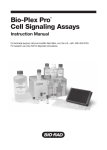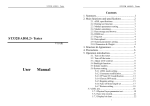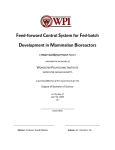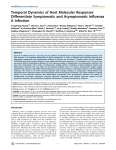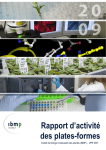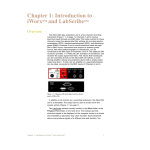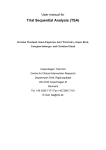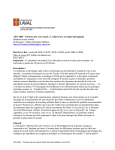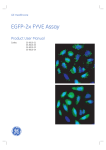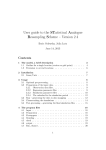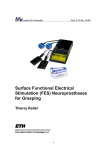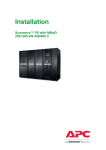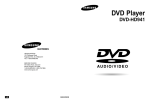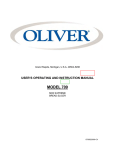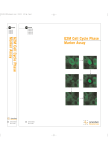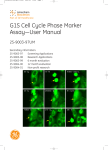Download 25-8010-38UM Rev B 2006.indd - GE Healthcare Life Sciences
Transcript
GE Healthcare EGFP-STAT3 Assay Product User Manual Codes: 25-8010-38 25-8010-39 25-8010-40 25-8010-41 Page finder 1. Introduction 1.1. STAT3 1.2. EGFP-STAT3 assay 3 3 4 2. Licensing considerations 2.1. Right to use 2.2. Legal 6 6 6 5.4.7. Effect of different assay media 5.4.8. Effect of serum starvation 5.4.9. Effect of using DRAQ5 nuclear stain 5.4.10. Fixed Assay 5.4.11. AG490 imhibition curve 5.4.12. Results obtained on the IN Cell Analyzer 1000 3. Product contents 8 3.1. Component summary 8 3.2. BHK derived cell line expressing EGFP-STAT3 fusion protein - NIF2027 8 3.2.1. BHK derived parental cell line 8 3.2.2. BHK derived EGFP-STAT3 expressing cell line 8 3.3. EGFP-STAT3 expression vector - NIF2028 8 3.4. Materials and equipment required 9 3.5. IN Cell Analysis System 9 3.5.1. IN Cell Analyzer 3000 9 3.5.2. Nuclear Trafficking Analysis Module 9 3.5.3. IN Cell Analyzer 1000 9 3.6. EGFP-STAT3 translocation assay on epifluorescence microscopes 10 3.7. Software requirements 10 4. Safety warnings, handling and precautions 4.1. Safety warnings 4.2. Storage 4.3. Handling 4.3.1. Vector 4.3.2. Cells 11 11 12 12 12 12 5. Cell assay design 5.1. Culture and maintenance of BHK derived EGFPSTAT3 expressing cell line 5.1.1. Tissue culture media and reagents required 5.1.2. Reagent preparation 5.1.3. Cell thawing procedure 5.1.4. Cell subculturing procedure 5.1.5. Cell seeding procedure 5.1.6. Cell freezing procedure 5.1.7. Growth characteristics 5.2. Assay set up 5.2.1. Live cell EGFP-STAT3 assay using the IN Cell Analyzer 3000 5.2.2. Microplate set up for 96 well format assays 5.2.3. Schematic agonist assay protocol 5.2.4. Agonist assay protocol (96 well format) 5.2.5. Fixed cell assay format 5.3. Results 5.3.1. Calculating the Z’-factor 5.3.2. Example results 5.4. Assay characterization 5.4.1. Translocation index 5.4.2. Summary of quantitative assay parameters 5.4.3. Seeding density 5.4.4. IL-6 dose response 5.4.5. Time course 5.4.6. Sensitivity of assay to DMSO, ethanol, and methanol 13 25-8010-38UM Pagefinder, Rev B, 2006 22 22 23 23 23 24 6. Vector use details 6.1. General guidelines for vector use 6.2. Transient transfection with pCORON1000 EGFP-STAT3 6.3. Stable cell line generation with pCORON1000 EGFP-STAT3 25 25 25 7. Quality control 7.1. EGFP-STAT3 cell line 7.2. EGFP-STAT3 expression vector 26 26 26 8. Troubleshooting guide 27 9. References 28 10. Related products 30 11. Appendix 11.1. Appendix A: Restriction map of pCORON1000 EGFP-STAT3 31 25 31 13 13 13 14 14 15 15 15 16 16 16 16 17 17 18 18 18 19 19 19 20 20 20 Front cover: Top image: BHK cells expressing the EGFP-STAT3 fusion protein 25 minutes after the addition of control buffer only. Bottom image: BHK cells expressing the EGFP-STAT3 fusion protein 25 minutes after stimulation with agonist (30 ng/ml IL-6). Images shown are 1/14th of the actual image size acquired by the IN Cell Analyzer 3000. BioImage is a Danish Biotech company specializing in developing drug candidates that exert their activity through modulation of protein translocation. For more information, visit their Web site at www.bioimage.dk 21 2 1. Introduction 1.1. STAT3 Signal transducers and activators of transcription (STATs) are a family of latent transcription factors that are activated in response to binding of polypeptide signalling molecules to cell membrane receptors. Activated STAT proteins form dimers that translocate to the nucleus, where they bind to promoter regions in target genes and ultimately modify the pattern of gene expression (1, 2, 3, 4). Seven mammalian STAT genes have been identified in three chromosomal clusters (5). The encoded proteins (STAT1, STAT2, STAT3, STAT4, STAT5a, STAT5b and STAT6) are activated by distinct sets of cytokines and growth factors, and each STAT protein activates a distinct set of target genes. STAT proteins were initially described in the context of cell signalling, where they contribute to such diverse processes as development, differentiation, proliferation and apoptosis (1, 2). Increasingly a role for STAT proteins, particularly STAT3, in transformation and tumor progression is being defined (6). STAT3 was first described as a DNA-binding activity, isolated from IL-6 stimulated hepatocytes, that was capable of selectively binding to an enhancer element in the promoter of acute phase genes (7, 8). In fact, given the correct physiological context STAT3 is activated not only by IL-6, but by the entire family of IL-6-type cytokines including IL-11, leukemia inhibitory factor, ciliary neurotrophic factor, oncostatin M, cardiotrophin-1 and cardiotrophin-like cytokine (9). Non-cytokine ligands such as epidermal growth factor, hepatocyte growth factor, platelet derived growth factor, granulocyte colony-stimulating factor and leptin have all been shown to activate STAT3 (3, 10). Upon stimulation of cell surface receptors, STAT3 proteins are recruited to activated receptors through an interaction between the STAT3 src homology 2 (SH2) domain and phosphotyrosine docking sites on the receptors’ intracellular domains. Subsequently, STAT3 is phosphorylated at a single site close to the carboxy-terminus (Tyr705) either directly by the receptor kinase or indirectly by a receptor associated Janus kinase (Jak). Following phosphorylation, STAT3 forms a dimer in which the SH2 domain of one STAT3 molecule binds to the phosphorylated Tyr705 of the other and vice versa. The STAT3 dimer then translocates through the cytoplasm to the nucleus (4). The processes by which this occurs are poorly understood although receptor-mediated endocytosis may be involved (11). Within the nucleus, STAT3 dimers recognize and bind an 8–10 base pair inverted repeat DNA element with a consensus sequence 5’TT(N4–6)AA-3’ commonly referred to as a GAS element (IFN-g-activated sequence) and initiate a change in transcription (2). In mammalian cells the time scale for STAT activation and nuclear import is typically in the range of 5–60 minutes following stimulation. During the subsequent period of signalling decay STATs are exported from the nucleus back to the cytoplasm; in the case of STAT3 this event is dependent on multiple nuclear export signals (12). As would be expected, STAT signalling is highly regulated and several regulatory processes are involved, although the complete pathway for individual STATs remains unclear. Deactivation of signalling from the cell surface can occur by degradation of the receptor-ligand complex via the ubiquitinproteosome pathway (13) and through the induction of the suppressor of cytokine signaling (SOCS) family of proteins, which inhibit Jaks (14). Further, a number of phosphatases, acting either at the receptor or at the receptor associated Jak, can lead to a cessation of STAT signalling (15, 16). The STAT proteins themselves can also be dephosphorylated by specific phosphatases in both the cytoplasmic and nuclear compartments (17, 18). Protein inhibitors of activated STATs (PIAS) bind to STAT dimers in the nucleus preventing DNA recognition (19). Structurally, STAT3 is similar to other STAT proteins and has four main domains (Fig 1.1). The first, an amino-terminal oligomerization domain, is involved in stabilizing STAT3 dimer-DNA interactions. An 18 amino-acid flexible polypeptide chain (coiled25-8010-38UM Chapter 1, Rev B, 2006 3 coil region) links the oligomerization domain to the DNA-binding domain, which confers binding specificity. The SH2 domain, which is the most highly conserved STAT domain, is necessary for receptor recruitment, association with activating JAKs and STAT3 dimerization. Finally, the carboxy-terminal transactivation domain is involved in transcriptional regulation of target genes. In addition to phosphorylation within the dimerization domain at Tyr705, phosphorylation of Ser727 within the transactivation domain appears to contribute to maximal transcriptional activity of STAT3, possibly by enhancing the recruitment of transcriptional cofactors (20, 21). Coiled-coil Linker Oligomerization DNA binding SH2 Y Dimerization S Transactivation Fig 1.1. Schematic showing major structural features of STAT3 including conserved tyrosine (Y) and serine (S) phosphorylation sites. STAT3 appears to regulate different genes in different cell types. For example, its induction of the anti-apoptopic gene Bcl-2 in B cells results in cell proliferation, while it’s down regulation of c-myc and c-myb and induction of junB and IRF-1 in monocytic cells are linked to cell differentiation and growth arrest (22). Defining other functions for STAT3 has been somewhat difficult since STAT3 knockout mice die early in embryogenesis (23); it has been postulated that STAT3 is involved in providing nutritional support to the implanted blastocyst. Experiments using mice in which STAT3 is ablated in a specific tissue or cell lineage have shown an involvement of STAT3 signalling in IL-6 dependent T cell proliferation (24), skin remodeling (25), deactivation of macrophages and neutrophils (26), motorneuron survival following axotomy (27) and mammary gland involution upon forced weaning (28). STAT3 signalling has recently been shown to be involved in leptin induced melanocortin production and body energy homeostasis (29) making it an attractive therapeutic target for the control of obesity. Since the discovery that STAT3 is constitutively phosphorylated in v-srctransformed cells, there is increasing evidence that aberrant STAT3 signalling is involved in oncogenesis. In particular, STAT3 is associated with cancers of the head, neck and breast, and with multiple myelomas, leukemias and lymphomas (6). Thus the STAT3 signalling pathway is an attractive target for therapeutic intervention in a number of human cancers. 1.2. EGFP-STAT3 assay A cell-screening assay examining the STAT3 signalling pathway (Fig 1.2.) has been developed. The assay is based on Redistribution™ technology and quantifies the intracellular location of a EGFP-STAT3 fusion protein in a stably transfected mammalian cell line. The STAT3 Redistribution assay monitors translocation of EGFP-STAT3 from the cytoplasm to the nucleus of cells stimulated with IL-6 Fig 1.2. Schematic of the STAT3 signalling pathway (provided with permission from BioCarta, www. biocarta.com). Cytokines Extracellular Cytoplasm P P JAKs P P TYK2 Tyr7 P STAT3 STAT3 P Tyr7 mTOR STAT3P STAT3 P MAPK P P DNA Ser7 STAT3 P Transcription P STAT3 Nucleus 25-8010-38UM Chapter 1, ISRE/GAS Rev B, 2006 4 (Fig. 1.3.). This assay is optimized for image acquisition and analysis on the IN Cell Analyzer 3000, using the Nuclear Trafficking Analysis Module, although the assay can also be imaged on the IN Cell Analyzer 1000 and other subcellular imaging systems. Using the recommended assay format, IL-6 has an EC50 value of 19.4 ng/ml. Fig 1.3. Agonist-induced redistribution of EGFP-STAT3 from the cytoplasm to the nucleus. Agonist, 25 minutes Un-stimulated cell: Majority of EGFP-STAT3 localized in cytoplasm . 25-8010-38UM Chapter 1, Rev B, 2006 Stimulated cell: EGFP-STAT3 redistributes to nucleus . 5 2. Licensing considerations 2.1. Right to use Use of this assay is limited as stated in the terms and conditions of sale. These vary in accordance with the product code purchased. Description Product Code EGFP-STAT3 Assay, Screening applications 25-8010-38 EGFP-STAT3 Assay, Research applications 25-8010-39 EGFP-STAT3 Assay, 6 month assay evaluation 25-8010-40 EGFP-STAT3 Assay, 12 month assay evaluation 25-8010-41 The assay was developed in collaboration with BioImage A/S and sold under license from: BioImage A/S under patents US 6172188, US 5958713, US6518021, EP851874, EP0815257, EP0986753 and other pending and foreign patent applications; and Invitrogen IP Holdings Inc (formerly Aurora Biosciences Corporation) under US patents US 5625048, 5777079, 5804387, 5968738, 5994077, 6054321, 6066476, 6077707, 6090919, 6124128, 6319969, 6403374 European patent 1104769 , 0804457 and Japanese patent JP 3283523 and other pending and foreign patent applications; and Columbia University. This product is sold under license from Columbia University under US patents. 5491084 and 646826. Rights to use this product, as configured, are limited to internal use for screening, development and discovery of therapeutic products; NOT FOR DIAGNOSTIC USE OR THERAPEUTIC USE IN HUMANS OR ANIMALS. No other rights are conveyed; and University of Florida Research Foundation under patents US 5968750, 5874304, 5795737, 6020192 and other pending and foreign patent applications; and Iowa Research Foundation. The CMV promoter is covered under US patents 5168062 and 5385839 and its use is permitted for research purposes only. Any other use of the CMV promoter requires a license from the University of Iowa Research Foundation 214 Technology Innovation Center Iowa City IA52242 USA; and Osaka University under US patents 5,719,042 , 5,844,082, CA patent 2145969, CN patent 1073157 and other pending and foreign patent applications. The exact terms of use for the product as configured are specified in the Terms and Conditions of Sale accompanying the product, but are limited to internal use for development and discovery of therapeutic products. No rights other than those expressly granted are conveyed. 2.2. Legal GE and GE monogram are trademarks of General Electric Company. Cy is a trademark of GE Healthcare companies. BioImage and Redistribution are trademarks of BioImage A/S Biocarta is a trademark of Biocarta Inc FuGENE is a trademark of Fugent, LLC Microsoft is a trademark of Microsoft Corporation 25-8010-38UM Chapter 2, Rev B, 2006 6 Hoechst is a trademark of Aventis Geneticin is a trademark of Life Technologies Inc DRAQ5 is a trademark of Biostatus Limited © 2006 General Electric Company – All rights reserved. GE Healthcare reserves the right, subject to any regulatory and contractual approval, if required, to make changes in specification and features shown herein, or discontinue the product described at any time without notice or obligation. Contact your GE Healthcare representative for the most current information and a copy of the terms and conditions http//www.gehealthcare.com/lifesciences GE Healthcare UK Limited Amersham Place Little Chalfont Buckinghamshire HP7 9NA UK 25-8010-38UM Chapter 2, Rev B, 2006 7 3. Product contents 3.1. Component summary • BHK derived cells expressing the EGFP-STAT3 fusion protein (two vials, each containing 1 ml and 1 x 106 cells) - NIF2027 • pCORON1000 EGFP-STAT3 expression vector (one vial containing 10 μg DNA, at a concentration of 250 μg/ml, supplied in TE buffer: 10 mM Tris, 1 mM EDTA pH 8.0) - NIF2028 • User manual 3.2. BHK derived cell line expressing EGFPSTAT3 fusion protein - NIF2027 3.2.1. BHK derived parental cell line The parental cell line BHK-21 (C-13) (ATCC CCL-10) was derived from the kidneys of five unsexed, one-day-old hamsters (30). Following 84 days of continuous cultivation, interrupted only by an eight-day preservation by freezing, clone 13 was initiated by single-cell isolation (31). 3.2.2. BHK derived EGFP-STAT3 expressing cell line BHK-21 cells were transfected with the pCORON1000 EGFP-STAT3 vector (supplied) using the FuGENE 6 transfection method according to the manufacturer’s instructions. A stable clone expressing the recombinant fusion protein was selected using 1 mg/ml Geneticin for approximately two weeks. The isolated clone was chosen at passage 12 and grown for a further 10 passages before being sorted using a FACS machine. Following sorting, the cells were grown for a further 8 passages before freezing. The cells have been tested and found to be negative for mycoplasma, bacteria and yeast (testing details available on request). 3.3. EGFP-STAT3 expression vector - NIF2028 The 8.493 kb plasmid, pCORON1000 EGFP-STAT3, contains a bacterial ampicillin resistance gene and a mammalian neomycin resistance gene (see Fig 3.1.) The sequence of the construct is available on a CD, upon request. Please e-mail [email protected] A detailed restriction map is shown in chapter 11, appendix A. Fig 3.1. Vector map of the supplied EGFP-STAT3 expression vector. Bsr GI (97) C MV enhancer PvuI (665) CMV promoter Hind III (757) Ampicillin resistancegene Chimeric intron PvuI (7220) T7 promoter EGFP BamHI (6407) Synthetic poly A pCORON1000-EGFP-STAT3 8493 bp Bsr GI (1817) Neomycin resistance gene Bam HI (2992) Hin dIII (5435) SV40 minimum origin of replication SV40 enhancer /early promoter STAT3 f1 ori PvuI (4465) NotI (4176) SV40 late polyA 25-8010-38UM Chapter 3, Rev B, 2006 8 3.4. Materials and equipment required The following materials and equipment are required, but not provided. • Microplates. For analysis using the IN Cell Analyzer 3000, Packard Black 96 Well ViewPlates (Packard Cat # 6005182) should be used. For assays in 384 well format, please e-mail [email protected] for recommendations. • A CASY 1 Cell Counter and Analyzer System (Model TT) (Schärfe System GmbH) is recommended to ensure accurate cell counting prior to seeding. Alternatively a hemocytometer may be used. • Environmentally controlled incubator (5% CO2, 95% relative humidity, 37°C) • Imager / microscope (e.g. IN Cell Analyzer 3000) • Laminar flow cell culture bench • Tissue culture flasks (T-flasks) and pipettes • Controlled freezing rate device providing a controlled freezing rate of 1°C per minute • Standard tissue culture reagents and facilities (section 5.1.1.) 3.5. IN Cell Analysis System The EGFP-STAT3 assay has been developed and optimized for analysis using the IN Cell Analyzer 3000, in conjunction with the Nuclear Trafficking Analysis Module. Please refer to the instrument user manual for details on instrument set up and the analysis module manual for details on the algorithm settings. The assay can also be imaged and analyzed with the IN Cell Analyzer 1000 system. For further information on either of these products, please contact GE Healthcare. 3.5.1. IN Cell Analyzer 3000 The IN Cell Analyzer 3000 is a line-scanning, laser-based, confocal imaging system, with three high-speed CCD cameras. It has been developed specifically for performing information-rich cellular assays very rapidly and at high resolution, enabling high-throughput and high-content testing of drug compounds. 3.5.2. Nuclear Trafficking Analysis Module The Nuclear Trafficking Analysis Module provides a method to quantify the movement of target molecules between the cytoplasm and the nucleus in either direction. The fluorescence intensity of a target molecule in discrete nuclear and cytoplasmic regions is measured and the ratio of the sampled intensities calculated as an index of translocation. 3.5.3. IN Cell Analyzer 1000 The IN Cell Analyzer 1000 is a bench top automated microscope system designed for imaging sub-cellular end-point assays. The systems’ core components are a Nikon microscope, xenon lamp and high-resolution CCD camera. Additional optional modules include liquid handling (both compound and reservoir dispense as well as aspirate) and temperature control to enable imaging live-cell assays over extended periods and in real-time. The IN Cell Analyzer 1000 system has a number of complementary analysis modules, as well as the capability to export images and data into other commercial analysis packages. The Nuclear Trafficking Analysis Module for the IN Cell Analyzer 1000 measures nuclear translocation by comparing sampled fluorescence intensity of the labeled molecule in the nuclear and cytoplasmic compartments. 25-8010-38UM Chapter 3, Rev B, 2006 9 3.6. EGFP-STAT3 translocation assay on epifluorescence microscopes For speed of screening and quality of the images obtained, we recommend performing the EGFP-STAT3 assay on the IN Cell Analyzer systems. However, it is possible to adapt the assay to be read on alternative imaging platforms. Laboratory grade inverted epifluorescence microscopes such as the Nikon Diaphot or Eclipse models or the Zeiss Axiovert model are suitable for image acquisition. A high-quality objective (Plan/Fluor 40 x 1.3 NA or similar) and epifluoresence filter sets compatible with GFP and the desired nuclear dye will be required. A motorized stage with multi-well plate holder and a heated stage enclosure are also recommended for assays performed on epifluorescence microscopes, and a suitable software package will be required for image analysis. 3.7. Software requirements IN Cell Analysis System Nuclear Trafficking Analysis Modules are available from GE Healthcare for automated image analysis of the EGFP-STAT3 assay for both the IN Cell Analyzer 1000 and the IN Cell Analyzer 3000. Analyzed data are exported as numerical files in ASCII format. ASCII format data can be imported into Microsoft™ Excel, Microsoft Access, or any similar package for further data analysis as desired. Confocal or epifluorescence microscope Suitable software will be required for analysis of images acquired on microscopes other than the IN Cell Analysis systems. 25-8010-38UM Chapter 3, Rev B, 2006 10 4. Safety warnings, handling and precautions 4.1. Safety warnings Warning: For research use only. Not recommended or intended for diagnosis of disease in humans or animals. Do not use internally or externally in humans or animals. All chemicals should be considered as potentially hazardous. We therefore recommend that this product is handled only by those persons who have been trained in laboratory techniques and that it is used in accordance with the principles of good laboratory practice. Wear suitable protective clothing such as laboratory overalls, safety glasses and gloves. Care should be taken to avoid contact with skin or eyes. In the case of contact with skin or eyes wash immediately with water CAUTION! Contains genetically modified material Genetically modified cells supplied in this package are for use in a suitably equipped laboratory environment. Users within the jurisdiction of the European Union are bound by the provisions of European Directive 98/81/EC which amends Directive 90/219/EEC on Contained Use of Genetically Modified Micro-Organisms. These requirements are translated into local law, which MUST be followed. In the case of the UK this is the GMO (Contained Use) Regulations 2000. Information to assist users in producing their own risk assessments is provided in sections 3.3.1. and 3.3.2. of ‘The Genetically Modified Organisms (contained use) Regulations 2000’ http://www.legislation.hmso.gov.uk/si/si2000/20002831.htm . Risk assessments made under ‘The Genetically Modified Organisms (Contained Use) Regulations 2000’ for our preparation and transport of these cells indicate that containment 1 is necessary to control risk. This risk is classified as GM Class 1 (lowest category) in the United Kingdom. For handling precautions within the United States, consult the National Institute of Health’s Guidelines for Research Involving Recombinant DNA Molecules. Instructions relating to the handling, use, storage and disposal of genetically modified materials: 1. These components are shipped in liquid nitrogen vapor. To avoid the risk of burns, extreme care should be taken when removing the samples from the vapor and transferring to a liquid nitrogen storage unit. When removing the cells from liquid nitrogen storage and thawing there is the possibility of an increase in pressure within the vial due to residual liquid nitrogen being present. Appropriate care should be taken when opening the vial. 2. Genetically modified cells supplied in this package are for use in a suitably equipped laboratory environment and should be used only by responsible persons in authorized areas. Care should be taken to prevent ingestion or contact with skin or clothing. Protective clothing, such as laboratory overalls, safety glasses and gloves, should be worn whenever genetically modified materials are handled. 3. Avoid actions that could lead to the ingestion of these materials and NO smoking, drinking or eating should be allowed in areas where genetically modified materials are used. 4. Any spills of genetically modified material should be cleaned immediately with a suitable disinfectant. 25-8010-38UM Chapter 4, Rev B, 2006 11 5. Hands should be washed after using genetically modified materials. 6. Care should be taken to ensure that the cells are NOT warmed if they are NOT being used immediately. To maintain viability DO NOT centrifuge the cells upon thawing. 7. Most countries have legislation governing the handling, use, storage, disposal and transportation of genetically modified materials. The instructions set out above complement Local Regulations or Codes of Practice. Users of these products MUST make themselves aware of and observe relevant Local Regulations or Codes of Practice. For further information, refer to the material safety data sheet(s) and / or safety statement(s). 4.2. Storage The EGFP-STAT3 expressing DNA construct (NIF2028) should be stored at -15°C to -30°C. The BHK-derived cells expressing the EGFP-STAT3 fusion protein (NIF2027) should be stored at -196°C in liquid nitrogen. 4.3. Handling Upon receipt, the cells should be removed from the cryo-porter and transferred to a gaseous phase liquid nitrogen storage unit. Care should be taken to ensure that the cells are not warmed unless they are required immediately. The vector should be removed from the cryo-porter and stored at -20°C until required. 4.3.1. Vector After thawing the DNA sample, centrifuge briefly to recover the contents. 4.3.2. Cells Do not centrifuge the cell samples upon thawing. 25-8010-38UM Chapter 4, Rev B, 2006 12 5. Cell assay design 5.1. Culture and maintenance of BHK derived EGFP-STAT3 expressing cell line 5.1.1. Tissue culture media and reagents required The following media and buffers are required to culture, maintain and prepare the cells, and to perform the assay. • GIBCO Dulbecco’s Modified Eagle Media (DMEM) with Glutamax-1, Invitrogen life technologies 31966-021 or equivalent • GIBCO Nutrient Mixture F-12 Ham medium with Glutamax, Invitrogen life technologies 31765-027 or equivalent • Fetal Bovine Serum (FBS), JRH Biosciences 12103 or equivalent. • GIBCO Penicillin-Streptomycin (P/S), (10 000 units/ml penicillin G sodium and 10 000 μg/ml streptomycin sulfate), Invitrogen life technologies 15140-122 or equivalent • Geneticin (G418), Sigma G-7034 or equivalent • GIBCO Trypsin-EDTA in HBSS w/o calcium or magnesium, Invitrogen life technologies 25300-054 or equivalent • GIBCO HEPES Buffer, 1M solution, Invitrogen life technologies 15630-056 or equivalent • Bovine serum albumin (BSA), Sigma A-7888 or equivalent • GIBCO Phosphate-Buffered Saline (PBS) Dulbecco’s, w/o calcium, magnesium or sodium bicarbonate, Invitrogen life technologies 14190-094 or equivalent • Dimethylsulfoxide (DMSO), Sigma D-2650 or equivalent • Hoechst™ 33342, Molecular Probes H-21492 or similar • DRAQ5™, Biostatus • Interleukin-6, Human, Recombinant, E. coli (IL-6), Calbiochem 407652 • Cy™5 monocarboxyl dye, GE Healthcare PA05111 or equivalent • Oregon Green (2’, 7’-difluorofluorescein), Molecular Probes D-6145 • Alexa Fluor (carboxylic acid, succinimidyl ester), Molecular Probes A-10168 • Formalin solution (10%), neutral-buffered, 4% (w/v) Formaldehyde, Sigma HT501-2 • Phosphate buffered saline tablets, Sigma, P-4417 • Standard tissue culture plastic-ware including tissue culture treated flasks (T-flasks), centrifuge tubes and cryo-vials 5.1.2. Reagent preparation NOTE: the following reagents are required, but not supplied. • Heat inactivation of FBS: 30 minutes in water bath at 56°C • Growth-medium: DMEM with Glutamax-1 supplemented with 10% (v/v) FBS, 1% (v/v) Penicillin-Streptomycin, and 0.5 mg/ml Geneticin • Freeze-medium: DMEM with Glutamax-1 supplemented with 10% (v/v) FBS, 1% (v/v) Penicillin-Streptomycin and 10% (v/v) DMSO • Assay-medium: Nutrient Mixture F-12 Ham medium with Glutamax supplemented with 10 mM HEPES, 0.2% (w/v) BSA and 1.0 μM Hoechst Nuclearstain. 25-8010-38UM Chapter 5, Rev B, 2006 13 • 10 μg/ml IL-6: IL-6 reconstituted as recommended by the supplier. Add 1 ml of sterile PBS containing 0.1% BSA to 10 μg IL-6. The stock solution of 10 μg/ml IL-6 can be aliquoted and stored between +4°C and -70°C until required. As recommended by the supplier, stock solutions are stable for 1 month at +4°C or for 3 months at -70°C. On the day of the assay the stock solution of IL-6 is further diluted in Assay-medium for use in the assay (see section 5.2.4. for further details). • Flat field (FF) solution components: • Cy5 - 1 mM stock solution prepared in 10% (v/v) DMSO, 90% (v/v) PBS • Oregon Green - 1 mM stock solution prepared in 10% (v/v) DMSO, 90% (v/v) PBS • Alexa Fluor - 1 mM stock solution prepared in 10% (v/v) DMSO, 90% (v/v) PBS As explained in the IN Cell Analyzer 3000 user manual, prepare the FF solution to give adequate fluorescent signal in each channel used, where the fluorescent counts should be less than 3300, at maximum. For a Hoechst 33342 nuclear stained assay, prepare an initial FF solution containing 1.0 μl 10 μM Oregon Green and 20 μl 100 μM Alexa Fluor in 100 μl PBS. For a DRAQ5 nuclear stained assay, prepare an initial FF solution containing 1.0 μl 10 μM Oregon Green and 10 μl 10 μM Cy5 in 100 μl PBS. Adjust these solutions if required. Use 100 μl of FF solution for a 96 well plate and 40 μl FF solution for a 384 well plate. 5.1.3. Cell thawing procedure Two cryo-vials, each containing 1 x 106 cells in 1 ml of Freeze-medium are included with this assay kit. The vials are stored frozen in the vapor phase of liquid nitrogen. 1. Remove a cryo-vial from storage. 2. Holding the cryo-vial, dip the bottom three-quarters of the cryo-vial into a 37°C water bath, and swirl gently for 1–2 minutes until the contents are thawed. Do not thaw the cells for longer than 3 minutes as this decreases viability. 3. Remove the cryo-vial from the water bath and wipe it with 70% (v/v) ethanol. Transfer the cells immediately to a T-25 flask and add 5 ml pre-warmed Growthmedium drop-wise to prevent cell damage. Add a further 2 ml Growth-medium and incubate at 37°C. NOTE: To ensure maximum cell viability, do not allow the cells to thaw at room temperature and do not thaw the cells by hand. 5.1.4. Cell subculturing procedure Incubation: 5% CO2, 95% humidity, 37°C. The cells should be passaged at a ratio of 1:20 when they are 90% confluent. 1. Warm all reagents to 37°C. 2. Aspirate the medium from the cells and discard. 3. Wash the cells with PBS. Take care not to damage the cell layer while washing, but ensure that the entire cell surface is washed. 4. Aspirate the PBS from the cells and discard. 5. Add Trypsin-EDTA (2 ml for T-75 flasks and 4 ml for T-162 flasks), ensuring that all cells are in contact with the solution. Wait for 3–10 minutes for the cells to round up/loosen. Check on an inverted microscope. 6. When the cells are loose, tap the flask gently to dislodge the cells. Add Growthmedium (8 ml for T-75 and 6 ml for T-162 flasks) and gently resuspend the cells with a 10 ml pipette until all the clumps have dispersed. 7. Aspirate the cell suspension and dispense 0.5 ml cells into a new culture vessel. 25-8010-38UM Chapter 5, Rev B, 2006 14 5.1.5. Cell seeding procedure The following procedure is optimized for cells grown in standard T-75 and T-162 flasks to be seeded into 96 well microplates. 1. Warm all reagents to 37°C. 2. Aspirate the medium from the cells and discard. 3. Wash the cells with PBS. Take care not to damage the cell layer while washing, but ensure that the entire cell surface is washed. 4. Aspirate the PBS from the cells and discard. 5. Add Trypsin-EDTA (2 ml for T-75 and 4 ml for T-162 flasks), ensuring that all cells are in contact with the solution. Wait for 3–10 minutes for the cells to round up/loosen. Check on an inverted microscope. 6. When the cells are loose, tap the flask gently to dislodge the cells. Add Growthmedium (3 ml for T-75 and 6 ml for T-162 flasks) and gently resuspend the cells with a 10 ml pipette until all the clumps have dispersed. 7. Count the cells using either a CASY1 Cell Counter and Analyzer System (Model TT) or a hemocytometer. 8. Using fresh Growth-medium, adjust the cell density to deliver the desired number of cells to each well. For example, to add 0.8 x 104 cells per well in a volume of 200 μl, adjust the suspension to 4 x 104 cells per ml. We recommend a concentration of 4 x 104 cells per ml. 9. Dispense 200 μl of the cells into each well of the microplate, except the well reserved for the FF solution (see IN Cell Analyzer 3000 manual for further information). 10. Optionally, incubate the plates undisturbed on a level surface for 1 hour at room temperature (approximately 20°C). This treatment may reduce edge effects. 11. Incubate the plated cells for 24 hours at 37°C, 5% CO2, 95% humidity before starting the assay. NOTE: If the cells are near confluence prior to trypsinization, they should be passaged into two T-flasks. They will then be ready for seeding the following day. 5.1.6. Cell freezing procedure A decreased growth rate has been observed in cell populations after having undergone more than 10 passages. It is recommended that the users make early freeze downs of cells at low passage number after expanding from passage 1. 1. Harvest the cells as described in section 5.1.4. and resuspend the cells in a small volume of Growth-medium. 2. Count the cells as described in section 5.1.5. 3. Pellet the cells at approximately 300 g for 5 minutes. Aspirate the medium from the cells. 4. Gently resuspend the cells until no clumps remain in Freeze-medium at a concentration of 1 x 106 cells in 1 ml and transfer into cryo-vials. Each vial should contain 1 x 106 cells in 1 ml of Freeze-medium. 5. Transfer the vials to a cryo-freezing device and freeze at -80°C for 16–24 hours. 6. Transfer the vials to the vapor phase in a liquid nitrogen storage device. 5.1.7. Growth characteristics Under standard growth conditions, the cells should maintain an average size of 18.6 μm as measured using a CASY1 Cell Counter and Analyzer System (Model TT). The doubling time of the cell line in exponential growth phase has been determined to be approximately 13.4 hours under standard conditions (Fig 5.1.). The growth rate may decrease after having undergone more then 10 passages. 25-8010-38UM Chapter 5, Rev B, 2006 15 In (cell number) 12 Fig 5.1. Growth curve of the BHK-derived EGFP-STAT3 expressing cell line. Only points on the linear portion are shown. Doubling time = 13.4 hours. 10 8 6 0 25 50 75 100 125 Time (hours) 5.2. Assay set up 5.2.1. Live cell EGFP-STAT3 assay using the IN Cell Analyzer 3000 This manual provides a suggested protocol to use the EGFP-STAT3 assay for agonist screening on the IN Cell Analyzer 3000. 5.2.2. Microplate set up for 96 well format assays The EGFP-STAT3 assay is optimized for agonist format (see sections 5.2.3. and 5.2.4.). It is essential that the number of cells per well in the assay plates be consistent in order to minimize assay variability. IL-6 is used as a reference agonist with a typical EC50 value of 19.4 ng/ml. The EGFP-STAT3 assay can be used with either Hoechst or DRAQ5 as the Nuclear-stain. The majority of data presented in this manual were obtained using Hoechst stain. As explained in the IN Cell Analyzer 3000 user manual, each run must contain a flat field well to compensate for variations in fluorescence intensity across each image. It is possible to prepare a plate solely for this purpose. Alternatively, a designated well on each plate can contain flat field solution. When seeding the plate, this well must not contain any cells if the auxiliary flat field correction tool is to be applied in the analysis module. 5.2.3. Schematic agonist assay protocol Fig 5.2. shows a typical schematic of the agonist assay. The cells should be seeded in the appropriate microplate the day before the experiment. The Growthmedium is decanted, the cells are washed and Assay-medium added to each well. Following a 30 minute incubation at 37°C, 5% CO2, controls and test compound are added to required wells. After 25 minutes incubation, the microplates are Fig 5.2. Flow diagram showing a basic protocol suitable for a EGFP-STAT3 agonist screen. START Seed cells. Incubate overnight, 37 oC, 5% CO 2 . Decant, Wash, Decant. Add Assay-medium with nuclear-stain. Incubate 30 minutes, 37 oC, 5% CO 2 . Add control and test compounds. Incubate 25 minutes, 37 oC, 5% CO 2 . Image plate on IN Cell Analyzer 3000. STOP 25-8010-38UM Chapter 5, Rev B, 2006 16 placed into the IN Cell Analyzer 3000. The Nuclear Trafficking Analysis Module is used to analyze images from each well. 5.2.4. Agonist assay protocol (96 well format) NOTE: whenever possible, keep the microplate at 37°C, 5% CO2, and 95% humidity. 1. The day before starting the assay, seed 0.8 x 104 cells per well in 200 μl of Growth-medium. Incubate for 24 hours at 37°C, 5% CO2. If one of the wells on the cell plate is used for flat field correction, it should not contain cells. 2. On the day of the assay, prepare the test compounds, solvent controls (if used) and reference agonist control (IL-6). These samples are typically prepared at four fold of the final concentration in Assay-medium. For the reference agonist IL-6, a final concentration of 30 ng/ml is suitable. However, we recommend that users perform their own dose response curve to establish optimal agonist concentrations. The concentration range of IL-6 recommended for a doseresponse assay is 0.3 ng/ml to 1 μg/ml. 3. Decant the Growth-medium from the cell plate, removing all excess liquid and add 100 μl Assay-medium to wash the cells. Decant the wash. 4. Add 150 μl Assay-medium. Incubate at 37°C, 5% CO2 for 30 minutes. 5. Add 50 μl of the prepared four fold dilution stocks of the test and control compounds to the appropriate wells. If Hoechst 33342 is used as the nuclear stain, we recommend including a 6 second* time interval between addition to each well. The order of dispensing should be the same as the well imaging order. This ensures that cells in each well have been stimulated for the same period of time prior to imaging. The total well volume is 200 μl. 6. After the first well has incubated for 25 minutes, read the assay plate using the IN Cell Analyzer 3000. Alternatively for convenience, the live cell assay could be fixed at the peak translocation time point and then imaged on the IN Cell Analyzer 3000 (see section 5.2.5. for further details). 7. Perform the data analysis using the Nuclear Trafficking Analysis Module. *A time interval of 6 seconds is required when using Hoechst 33342 as the nuclear stain. This corresponds to the time taken to image one tile per well on the IN Cell Analyzer 3000, using 364 nm and 488 nm excitation on two excitation passes. If DRAQ5 is used as the nuclear stain, no delay is required, since the 488 nm and 647 nm channels can be imaged simultaneously. Any other changes to the protocol that may influence the time taken to image a well should be taken into consideration during test and control compound addition (e.g. imaging more than one tile per well). 5.2.5. Fixed cell assay format In order to avoid the need for strict time-controlled dispensing of test and control compounds, it is possible to complete the assay using live cells, as described in the agonist assay protocol, but fix the cells prior to imaging. 1. Perform the assay as described. 2. After incubating with agonist for the optimal time, decant the Assay-medium and wash the cells in each well with 200 μl PBS. Decant the wash. 3. Add 100 μl 2% formaldehyde in PBS and incubate for 30 minutes at room temperature. 4. Decant the fixative and wash the cells in each well with 200 μl PBS. Decant the wash. 5. Store the plate at 4°C with 100 μl fresh PBS in each well. 6. Image and perform analysis as required. If the cells are to be fixed, the assay can be performed with, the Nuclear-stain in the Assay-medium for the duration of the assay. Nuclear staining, at the same 25-8010-38UM Chapter 5, Rev B, 2006 17 concentrations as normal, can be performed after fixation. If no stain is used during the assay, the first PBS wash step can be omitted from the protocol. 5.3. Results 5.3.1. Calculating the Z’-factor Assay performance can be assessed by calculating the Z’-factor, a dimensionless value defined by Zhang et al. (32). Using the IN Cell Analyzer 3000, a Z’-factor of > 0.3 should be obtained with the assay under standard conditions, if the experiment is performed as described in this manual. Z’ = 1- (3σc+ + 3σc-) | μc+ - μc- | where σ = standard deviation μ = mean signal c+ = positive control c- = negative control 5.3.2. Example results The following figures (Fig 5.3. and Fig 5.4.) are taken from a single experiment, providing an example of the image quality and results that can be obtained with the EGFP-STAT3 assay, using the IN Cell Analyzer 3000. Fig 5.3. shows images acquired on the IN Cell Analyzer 3000 using the supplied BHK derived EGFP-STAT3 cell line. Images shown here are 1/14th of the full images acquired by the system. Fig 5.3. The BHK derived EGFP-STAT3 expressing cells 25 minutes after stimulation with (A) control buffer only or (B) 30 ng/ml IL-6. The field of cells shown is not the same. The nuclear (blue) image channel is not displayed here. A B Fig 5.4. Data from the example experiment, generated by the Nuclear Trafficking Analysis Module, exported to and analyzed in Microsoft Excel. Analysis of these results yielded a Z’-factor of 0.65 for the assay as performed using the conditions described in the legend to Fig 5.3. 25-8010-38UM Chapter 5, Rev B, 2006 18 5.4. Assay characterization 5.4.1. Translocation index All of the characterizations for the EGFP-STAT3 assay were performed on the IN Cell Analyzer 3000 using the Nuclear Trafficking Analysis Module. The translocation index for this assay is taken to be the Nuc/Cyt ratio reported for the cell population imaged in each well. The Nuc/Cyt ratio is the populationaveraged ratio of sampled nuclear and cytoplasmic intensities measured in the signal channel. This index is used in all the following data. 5.4.2. Summary of quantitative assay parameters Summaries of typical assay data, using IL-6 as the agonist, are shown in Tables 5.1. and 5.2. In particular, Table 5.1. shows the results calculated from a single assay plate, indicating the degree of well to well variation. Table 5.2. shows a summary of the results obtained from 19 assays, performed by different operators on different occasions, giving an indication of inter assay variation. Parameter Signal to Noise Z’-factor Magnitude of Response %CV Stimulated Unstimulated Assay Data 42.46 0.65 1.25 # Assays 1 1 1 # Replicates 48 48 48 4.77 2.57 1 1 48 48 Parameter Assay Data (± SD*) # Assays # Replicates Signal to Noise 33.93 ± 7.22 17 48 Z’-factor 0.51 ± 0.10 17 48 Magnitude of Response 1.10 ± 0.14 17 48 %CV Stimulated 6.32 ± 1.20 17 48 Unstimulated 2.79 ± 0.36 17 48 25-8010-38UM Chapter 5, Rev B, 2006 19 Table 5.1. Results from a typical single assay, performed using the suggested protocol. Signal to noise is calculated as (mean signal – mean background)/ (background standard deviation) (32). Magnitude of response is calculated as (mean signal – mean background). % CV is calculated as (standard deviation x 100)/mean. Z’-factor is a dimensionless characteristic useful for evaluation of assay quality (32). It is defined in section 5.3.1. Table 5.2. Summary results from assays performed by different operators on different occasions, using the suggested protocol. * SD shown is the Standard deviation of the assays Signal to noise is calculated as (mean signal – mean background)/ (background standard deviation) (32). Magnitude of response is calculated as (mean signal – mean background). % CV is calculated as (standard deviation x 100)/mean. Z’-factor is a dimensionless characteristic useful for evaluation of assay quality (32). It is defined in section 5.3.1. 5.4.3. Seeding density Fig 5.5. shows the effect of varying seeding density when the assay is performed in a 96 well microplate. The data were collected 25 minutes after the addition of assay buffer control or 30 ng/ml IL-6. Significant differences between stimulated (30 ng/ml IL-6) and non stimulated (no IL-6) cells were seen at cell densities ranging from 0.2 x 104 to 1.2 x 104 cells per well. We recommend seeding the cells at a density of 0.8 x 104 cells per well. Control (no IL-6) 30 ng/ml IL-6 Translocation index (Nuc/Cyt) 3 2 Fig 5.5. IL-6-induced EGFP-STAT3 translocation as a function of seeding density. Stimulated cells were treated with 30 ng/ml IL-6 for 25 minutes prior to imaging. Error = ± SD, n = 8 replicates per data point. 1 0 2000 4000 6000 8000 10000 12000 Cell Density (cells/well) 5.4.4. IL-6 dose response Fig 5.6. shows an agonist dose response curve for the IL-6 response. The data were collected 25 minutes after addition of agonist, and demonstrate an EC50 of 19.4 ng/ml. Fig 5.6. IL-6 dose response curve using the supplied EGFP-STAT3 cell line. Error = ± SD, n = 8 replicates per data point. Translocation index (Nuc/Cyt) 3 2 1 0 -2 -1 0 1 2 3 4 log [IL-6] (ng/ml) 5.4.5. Time course Fig 5.7. shows a typical time course of the EGFP-STAT3 translocation and indicates that the maximal translocation occurs approximately 25 minutes after stimulation with 30 ng/ml IL-6. Control (no IL 30 ng/ml IL-6 Translocation index (Nuc/Cyt) 3 2 1 0 0 10 20 30 40 50 Time (minutes) 25-8010-38UM Chapter 5, Rev B, 2006 20 Fig 5.7. Time course of EGFP-STAT3 translocation using 30 ng/ml IL-6 as agonist. Maximal response is seen after 25 minutes. Error = ± SD, n = 4 replicates per data point. 5.4.6. Sensitivity of assay to DMSO, ethanol, and methanol The EGFP-STAT3 translocation was measured in the presence of DMSO (≤ 2%), ethanol (≤ 2%) or methanol (≤ 2%). As can be seen in Fig 5.8. the IL-6 induced translocation can withstand at least 0.5% of each solvent. Control (no IL-6) 30 ng/ml IL-6 Translocation index (Nuc/Cyt) 3 Fig 5.8a. Effect of DMSO on the IL-6 induced EGFP-STAT3 translocation. Error = ± SD, n = 8 replicates per data point. 2 1 0 0.00% 0.10% 0.25% 0.50% 1.00% 2.00% DMSO % Control (no IL-6) 30 ng/ml IL-6 Translocation index (Nuc/Cyt) 3 Fig 5.8b. Effect of ethanol on the IL-6 induced EGFP-STAT3 translocation. Error = ± SD, n = 8 replicates per data point. 2 1 0 0.00% 0.10% 0.25% 0.50% 1.00% 2.00% Ethanol % Control (no IL-6) 30 ng/ml IL-6 Translocation index (Nuc/Cyt) 3 2 1 0 0.00% 0.10% 0.25% 0.50% 1.00% 2.00% Methanol % 25-8010-38UM Chapter 5, Rev B, 2006 21 Fig 5.8c. Effect of methanol on the IL-6 induced EGFP-STAT3 translocation. Error = ± SD, n = 8 replicates per data point. 5.4.7. Effect of different assay media To determine the effect of varying the assay medium on the IL-6 induced EGFPSTAT3 translocation, cells were assayed in either Nutrient Mixture F-12 Ham medium (Ham F-12) or Dulbecco’s Modified Eagle medium (DMEM) with a range of additives (10 mM HEPES, BSA and FBS). The results were collected 25 minutes after incubation in the absence or presence of 30 ng/ml IL-6. The results, shown in Fig 5.9, demonstrate that the assay tolerates a range of assay media. Control (no IL-6) 30 ng/ml IL-6 Translocation index (Nuc/Cyt) 3 Fig 5.9. The effect of different Assay Media on IL-6 induced translocation of EGFP-STAT3. Error = ± SD, n = 4 replicates per data point. 2 1 Ham Ham F-12 F-12 + 10 + 10 mM mM HEP Ham H ES E PES F-12 + 0.1 + 10 % mM BSA Ham HEP ES + F-12 0 .2% + 10 BSA mM Ham HEP F-12 E S+1 + 10 %F mM CS Ham HEP F-12 ES + + 10 5% FCS mM HEP ES + 10% DME FCS DME M+ M+ 1 0 10 m mM HEP MH ES DME EPE S+0 M+ .1% 10 m BSA MH EPE DME S+0 M+ . 2 10 m %B SA MH DME EPE S+1 M+ %F 10 m CS MH DME EPE M+ S+5 10 m %F CS MH EPE S+1 0% FCS 0 Assay-medium formulation 5.4.8. Effect of serum starvation To determine the effect of serum starving the cells prior to the assay, cells were incubated in Assay-medium for 1–4 hours. The results, shown in Fig 5.10, demonstrate that the assay tolerates a range of serum starvation times (including the 25 minutes IL-6 stimulation time) in the recommended Assay-medium. Control (no IL-6) 30 ng/ml IL-6 Translocation index (Nuc/Cyt) 3 2 1 0 1 2 3 4 Starvation time (hours) 25-8010-38UM Chapter 5, Rev B, 2006 22 Fig 5.10. The effect of serum starvation on IL-6 induced translocation of EGFP-STAT3. Error = ± SD, n = 4 replicates per data point. 5.4.9. Effect of using DRAQ5 nuclear stain GFP expressing cells which have been stained using Hoechst nuclear marker must be imaged sequentially due to overlap of spectral profiles for the two probes. For speed of imaging, the red nuclear marker DRAQ5 can be used instead of Hoechst. Since there is no spectral overlap between DRAQ5 and GFP, images can be acquired simultaneously. Fig 5.11 shows an IL-6 dose response curve where the nuclear marker has been changed to 0.3 μM DRAQ5. Fig 5.11. IL-6 dose response curve using 0.3 μM DRAQ5 as the nuclear marker. Error = ± SD, n=8 replicates per data point. EC50 = 3.9 ng/ml Translocation index Nuc/Cyt 3 2 1 0 -2 -1 0 1 2 3 log [IL-6] (ng/ml) 5.4.10. Fixed Assay In order to avoid the need for strict time-controlled dispensing, it is possible to complete the assay using live cells, as described in the agonist assay protocol, but fix the cells prior to analysis. For full details see section 5.2.5. Fig 5.12 shows results obtained from fixed preparations after 25 minutes stimulation with control (no IL-6) or 30 ng/ml IL-6. Cells were fixed with 2% formaldehyde in PBS. Fig 5.12. IL-6 induced EGFP-STAT3 translocation. Cells treated with either Control (no IL-6) or 30 ng/ml IL-6 for 25 minutes prior to fixation and imaging on the IN Cell Analyzer 3000. Error = ± SD, n = 48 replicates per data point. Translocation index (Nuc/Cyt) 3 2 1 0 Control (no IL-6) 30 ng/ml IL-6 5.4.11. AG490 inhibition curve Fig 5.13. shows an inhibition curve for the antagonist AG490. The data were collected 25 minutes after the addition of control (no IL-6) or 30 ng/ml IL-6 to cells which had been pre-incubated with varying concentrations of AG490 for 4 hours. An IC50 of 20 μM was obtained. Data were acquired from a single experiment, with 5 μM Hoechst nuclear stain as opposed to the recommended 1 μM Hoechst. Control (no IL-6) 30 ng/ml IL-6 Translocation index (Nuc/Cyt) 4 3 2 1 0 -8 -7 -6 -5 -4 -3 log [AG490] (M) 25-8010-38UM Chapter 5, Rev B, 2006 23 Fig 5.13. AG490 inhibition curve, in the presence of Control (no IL-6) or 30 ng/ml IL-6. Error = ± SD, n=4 replicates per data point. IC50 = 20 μM 5.4.12. Results obtained on the IN Cell Analyzer 1000 Fig 5.14. and Fig 5.15. show typical images and data for the EGFP-STAT3 translocation assay. After 25 minutes incubation in the absence or presence of 30 ng/ml IL-6, cells were fixed with 2% formaldehyde in PBS prior to imaging on the IN Cell Analyzer 1000. Fig 5.14. Images obtained using IN Cell Analyzer 1000. The BHK-derived EGFP-STAT3 expressing cells 25 minutes after stimulation with (A) control buffer only or (B) 30 ng/ml IL-6. A B Fig 5.15. Results obtained using the IN Cell Analyzer 1000 and associated Nuclear Trafficking Analysis Module. Translocation index (Nuc / Cyt) 1.4 1.2 1.0 0.8 Control (no IL-6) 25-8010-38UM Chapter 5, Rev B, 2006 30 ng/ml IL-6 24 6. Vector use details The plasmid vector pCORON1000 EGFP-STAT3 (Fig 3.1.) can be used to transiently or stably express EGFP-STAT3 fusion protein in the cell line of choice. 6.1. General guidelines for vector use pCORON1000 EGFP-STAT3 has been used successfully to express EGFP-STAT3 fusion protein both transiently and stably in the BHK derived cell line. Expression levels, translocation responses and other assay parameters may vary depending on the cell type and the transfection procedure. 6.2. Transient transfection with pCORON1000 EGFP-STAT3 Transient transfection protocols must be optimized for the cell type of choice. Choice of transfection reagent and cell type will affect efficiency of transfection. FuGENE 6 Transfection Reagent (Roche) produced successful results when transfecting pCORON1000 EGFP-STAT3 into BHK cells. For more information, refer to manufacturer’s guidelines for the desired transfection reagent. 6.3. Stable cell line generation with pCORON1000 EGFP-STAT3 The process of establishing stable cell lines involves a large number of variables, many of which are cell-line dependent. Standard methods and guidelines for the generation of stable cell lines are widely available in the public domain (33). pCORON1000 EGFP-STAT3 has been used to generate stably transfected cell populations. The magnitude of the response and the kinetics of the translocation event achievable with different cell lines are unknown, and may deviate considerably from the values specified in this manual. 25-8010-38UM Chapter 6, Rev B, 2006 25 7. Quality control 7.1. EGFP-STAT3 cell line The EGFP-STAT3 cell line is supplied at a concentration of 1 x 106 cells per ml in fetal calf serum containing 10% (v/v) DMSO. The cell line has the characteristics detailed in Table 7.1. Property Value Measurement method Magnitude of response ≥ 0.9 Z’-factor ≥ 0.3 For 10 passages after dispatch Quality Control Assay Viability from frozen > 80% CASY1 Cell Counter and Analyzer System (Model TT) Cell diameter (μm) 18–21 CASY1 Cell Counter and Analyzer System (Model TT) > 40 000 for 10 passages after dispatch FARCyte (Gain 51) Assay stability Fluorescence at 4 x 104 cells per ml (RFU) Table 7.1. Quality control information for EGFP-STAT3 cell line 7.2. EGFP-STAT3 expression vector The EGFP-STAT3 expression vector is supplied in TE buffer (10 mM Tris, 1 mM EDTA, pH 8.9) at 250 μg/ml. The vector has the characteristics outlined in Table 7.2. Property Value Concentration Limits Measurement method 250 μg/ml Purity - Minimal contamination of the DNA construct by RNA or protein A260/A280 ratio Expected restriction pattern The restriction digests should give fragments of the sizes shown in Table 7.3. UV Absorbance @ 260 nm in water Between 1.8–2.2 UV/Vis Absorbance @ 260 nm and 280 nm Agarose gel electrophoresis Enzyme(s) # of cuts Fragment(s) size (bp) BamHI BsrGI HindIII NotI PvuI 2 2 2 1 3 3415, 5078 1720, 6773 3815, 4678 8493 1938, 2755, 3800 25-8010-38UM Chapter 7, Rev B, 2006 Table 7.2. Quality control information for the EGFP-STAT3 expression vector 26 Table 7.3. Expected restriction pattern for the EGFP-STAT3 expression vector 8. Troubleshooting guide Problem Possible cause Remedy 1. Low assay response (positive vs negative controls). 1.1. Passage number too high. 1.1. Start a fresh batch of cells from an earlier passage number. Cells should be expanded, and additional vials should be frozen down from the vials delivered with the kit. 1.2. Cell density too low or too high. 1.2. Verify density of cell plating; adjust plating density to values that yield optimal assay response. 1.3. Incorrect selection of analysis parameters. 1.3. Check that the primary parameters are correct and suitable for the cells currently in use. 1.4. Incorrect assay/incubation conditions. 1.4. Ensure that proper incubation is maintained as consistently as possible during the assay. When plates are out of the CO2 incubator for extended periods, it is essential that HEPES buffer be added to the medium to maintain the correct pH. 1.5. Reagents were not stored properly or they are out of date. 1.5. Repeat assay with fresh reagents. 1.6. Cells have been stressed during assay. 1.6. Use actively growing cells maintained at 37°C. Pre-warm reagents to 37°C. 2.1. Nuclear-stain concentration too low. 2.1. Adjust Nuclear-stain concentration to recommended level. 2.2. Nuclear-stain incubation time too short. 2.2. Adjust Nuclear-stain incubation time to recommended length. 3. Image is out of focus. 3.1. Autofocus Offset is chosen incorrectly or the system may need to be realigned 3.1. Alignment and calibration of instrument. Perform Z-stack on cells. Change Autofocus Offset. 4. Cells do not adhere to well bottom in plate. 4.1. Plating density too high. 4.1. Reduce plating density. 5. Shading across image field. 5.1. Flat field correction not applied or flat field solution too weak. 5.1. Apply flat field correction or adjust flat field solution. 2. Low nuclear intensity. 25-8010-38UM Chapter 8, Rev B, 2006 27 9. References 1. Schindler, C., et al. Transcriptional responses to polypeptide ligands: the JAKSTAT pathway. Annu. Rev. Biochem. 64, 621–651 (1995). 2. Darnell, J.E. Stats and gene regulation. Science, 277, 1630–1635 (1997). 3. Kisseleva, T., et al. Signalling through the JAK/STAT pathway, recent advances and future challenges. Gene, 285, 1–24 (2002). 4. Levy, D.E., et al. What does Stat3 do? J. Clin. Invest. 109, 1143–1148 (2002). 5. Copeland, N.G., et al. Evolution of the mammalian Stat gene family. Genomics, 29, 225–228 (1995). 6. Bowman, T., et al. Stats in oncogensis. Oncogene, 19, 2472–2488 (2000). 7. Akira, S., et al. Molecular Cloning of APRF, a novel INF-stimulated gene factor 3 p91-related transcription factor involved in the gp130-mediated signalling pathway. Cell, 77, 63–71 (1994). 8. Zhong, Z., et al. Stat3 and Stat4: Members of the family of signal transducers and activators of transcription. Proc. Natl. Acad. Sci. 91, 4806–4810 (1994). 9. Hirano, T. Signaling mechanisms through gp130: a model of the cytokine system. Cytokine and Growth Factor Reviews. 8, 241–252 (1997). 10. Boccaccio. C., et al. Induction of epithelial tubules by growth factor HGF depends on the STAT pathway. Nature, 15, 285–288 (1998). 11. Bild A. H., et al. Cytoplasmic transport of Stat3 by receptor-mediated endocytosis. EMBO, 21, 3255–3263 (2002). 12. Bhattacharya, S., et al. Regulation of Stat3 nuclear export. J. Clin. Invest., 111, 553–559 (2003). 13. Callus, B.A., et al. Interleukin-3-induced activation of the JAK/STAT pathway is prolonged by proteasome inhibitors. Blood, 91, 3182–3192 (1998). 14. Hilton, D.J. Negative regulators of cytokine signal transduction. Cell Mol. Life Sci., 55, 1568–1577 (1999). 15. Irie-Sasaki, J., et al. CD45 is a JAK phosphatase and negatively regulates cytokine receptor signalling. Nature, 409, 349–354 (2001). 16. Myers, M. P., et al. TYK2 and JAK2 are substrates of protein-tyrosine phosphatase 1B. J. Biol. Chem. 276, 4771–47774 (2001). 17. Yamamoto, T., et al. The nuclear isoform of protein-tyrosine phosphatase TC-PTP regulates interleukin-6-mediated signalling pathway through Stat3 dephosphorylation. Biochem. Biophys. Res. Comm., 297, 811–817 (2002). 18. Hoeve, J., et al. Identification of a nuclear Stat1 protein tyrosine phosphatase. Mol. Cell. Biol., 22, 5662–5668 (2002). 19. Chung C.D. Specific inhibition of Stat3 signal transduction by PIAS3. Science 278, 1803–1805 (1997). 20. Wen, Z., et al. Maximal activation of transcription by Stat1 and Stat3 requires both tyrosine and serine phosphorylation. Cell, 82, 241–250 (1995). 21. Wen, Z., et al. Mapping of Stat3 serine phosphorylation to a single residue (727) and evidence that serine phosphorylation has no influence on DNA binding of Stat1 and Stat3. Nucleic Acids Res., 25, 2062–2067 (1997). 22. Hirano, T., et al. Roles of Stat3 in mediating the cell growth, differentiation and survival signals relayed through the IL-6 family of cytokine receptors. Oncogene, 19, 2548–2556 (2000). 25-8010-38UM Chapter 9, Rev B, 2006 28 23. Takeda, K., et al. Targeted disruption of the mouse Stat3 gene leads to early embryonic lethality. Proc. Natl. Acad. Sci., 94, 3801–3084 (1997). 24. Takeda, K., et al. Stat3 activation is responsible for IL-6-dependent T cell proliferation through preventing apoptosis: Generation and characterisation of T cell-specific Stat3 deficient mice. J. Immuno., 161, 4652–4660 (1998). 25. Sano, S., et al. Keratinocyte-specific ablation of Stat3 exhibits impaired skin remodeling, but does not affect skin morphogenesis. EMBO, 18, 4657–4668 (1999). 26. Takeda, K., et al. Enhanced Th1 activity and development of chronic entercolitis in mice devoid of Stat3 in macrophages and neutrophils. Immunity, 10, 39–49 (1999). 27. Schweizer, U., et al. Conditional gene ablation of Stat3 reveals differential signalling requirements for survival of motorneurons during development and after nerve injury in the adult. J. Cell Biol., 156, 287–297 (2002). 28. Chapman, R.S., et al. The role of Stat3 in apoptosis and mammary gland involution. Conditional deletion of Stat3. Adv. Exp. Med. Biol., 480, 129–38 (2000). 29. Bates, S. H., et al. Stat3 signalling is required for leptin regulation of energy balance but not reproduction. Nature, 421, 856–859 (2003). 30. Macpherson I. and Stoker M., Polyoma transformation of hamster cell clonesan investigation of genetic factors affecting cell competence. Virology 16, 147–151 (1962). 31. Macpherson I., Characteristics of a hamster cell clone transformed by polyoma virus. J. Natl. Cancer Inst. 30, 795–815 (1963). 32. Zhang, J. H., et al. A Simple Statistical Parameter for Use in Evaluation and Validation of High Throughput Screening Assays. J. Biomol. Screen. 4, 67–73 (1999). 33. Freshney, R. I. Cloning and Selection of Specific Cell Types in Culture of Animal Cells, 3rd Edition, Wiley-Liss Inc, Chapter 11, pp. 161–178 (1994). 25-8010-38UM Chapter 9, Rev B, 2006 29 10. Related products Product Name: Code: GFP Assays GFP-PLCδ-PH domain assay See below* GFP-Rac1 assay See below* GFP-MAPKAP-k2 assay See below* AKT1-EGFP assay See below* EGFP-2xFYVE assay See below* EGFP-SMAD2 assay See below* EGFP-NFATcl assay See below* CypHer pCORON1000 VSV-G tag Expression vector 25-8008-51 pCORON1000 SP VSV-G tag Expression vector 25-8009-92 CypHer5E labeled anti-VSV-G antibody PA45407 CypHer5E NHS ester (1 mg pack) PA15401 CypHer5E NHS ester (5 mg pack) PA15405 *Use of the GFP assays is limited as stated in the Terms and Conditions of Sale. The product codes vary accordingly. Please contact your local representative for details. IN Cell Analysis system IN Cell Analyzer 3000 25-8010-11 Nuclear Trafficking Analysis Module for the IN Cell Analyzer 3000 63-0048-96 IN Cell Analyzer 1000 25-8010-26 Nuclear Trafficking Analysis Module for the IN Cell Analyzer 1000 25-8010-31 25-8010-38UM Chapter 10, Rev B, 2006 30 11. Appendix 11.1. Appendix A: Restriction map of pCORON1000 EGFP-STAT3 The following enzymes do not cut the vector: ApaI, AscI, BbrPI, Bpu1102I, BsiWI, Bsp120I, Bst1107I, BstEII, CelII, EcoNI, EcoRV, EspI, KspI, NruI, PacI, PmaCI, PmeI, PmlI, SacII, SgrAI, SwaI Enzyme # of cuts Positions (c) indicates the complementary strand AatI 2 3200 5418 AatII 5 279 332 415 601 6670 Acc65I 2 1892 5069 AccI 1 4166 AccIII 3 1825 2306 2850 AciI 90 129 212 240 252 266 399 433 524(c) 557(c) 669 690(c) 767(c) 1326 1367 1434 1473 1611 1724 1784 1787 1944(c) 1990(c) 2061 2218(c) 2493(c) 2518(c) 2589(c) 2617 2826(c) 3630(c) 3636(c) 3740(c) 4035 4175(c) 4179 4456 4517(c) 4531(c) 4534(c) 4562 4589 4967(c) 4993(c) 5006 5014(c) 5082(c) 5267 5279 5288 5300 5310 5321 5367 5522 5585 5679(c) 5743(c) 5844(c) 5847(c) 6087 6127(c) 6132 6182(c) 6198 6224 6280(c) 6339 6411 6449 6475 6485 6524 6698(c) 6745 6844(c) 6953(c) 7030(c) 7074 7195(c) 7241 7432(c) 7523(c) 7885 7894(c) 8029 8139(c) 8260(c) 8279(c) 8406(c) 8434(c) AcsI 8 1843 2914 3001 3073 3496 4264 4918 4929 AcyI 11 276 329 412 598 2879 3277 3707 5613 6315 6667 7049 AflII 4 829 848 1051 5467 AflIII 3 1849 3296 3794 AgeI 1 1095 AluI 46 728 759 834 1048 1128 1161 1233 1266 1482 1530 1641 1815 1872 1881 1905 1914 1928 1941 2460 2514 2571 2787 2937 2983 3159 3380 3426 3786 3943 4303 4648 4905 5095 5383 5437 5719 6177 6538 6557 7236 7299 7399 7920 8177 8223 8313 Alw44I 3 6420 6917 8163 AlwI 23 1602(c) 1801 2330 2987(c) 3000 3365 3747(c) 4421(c) 4430 5024 5792 5857(c) 6038 6402(c) 6415 6950 6954(c) 7271 7734(c) 7735 7831(c) 7833 7919 AlwNI 7 1953 2215 2283 2460 3786 3955 8068 AosI 4 4484 5023 5715 7366 ApaLI 3 6420 6917 8163 ApoI 8 1843 2914 3001 3073 3496 4264 4918 4929 AseI 2 161 7414 AsnI 2 161 7414 Asp700 1 6989 Asp718 2 1892 5069 AspEI 1 7589 AspHI 9 730 1717 3652 5726 5916 6424 6921 7006 8167 AspI 1 5731 AsuII 1 6295 AvaI 2 1838 4170 AvaII 9 1764 2484 2739 2853 3372 3454 6129 7225 7447 AviII 4 4484 5023 5715 7366 25-8010-38UM Chapter 11, Rev B, 2006 31 Enzyme # of cuts Positions (c) indicates the complementary strand AvrII 1 5419 BamHI 2 2992 6407 BanI 11 619 977 1143 1892 2174 3664 4694 5069 5612 5647 7636 BanII 3 730 4664 5978 BbsI 2 962 3976 BbvI 45 821(c) 1253(c) 1359 1643 1650 1676(c) 1679(c) 1890 1914 1928(c) 2221 2266 2286 2301 2466 2469 2727 2763 2841 2992 3071 3146(c) 3435 3704 3792 3795 3942(c) 4016 4290(c) 4497 4565 5036 5560(c) 5686 5728 5744(c) 5837(c) 6249 6544(c) 7155(c) 7546 7849(c) 8055(c) 8058(c) 8148 BcgI 2 1232 7051(c) BclI 1 3167 BfaI 15 154 753 1058 1087 2326 2632 2641 3214 4231 4582 5420 5474 7396 7731 7984 BfrI 4 829 848 1051 5467 BglI 8 137 244 366 437 2218 4494 5372 7471 BglII 3 1834 2412 8489 BlnI 1 5419 BmyI 17 730 1148 1277 1526 1717 3019 3652 4664 5559 5652 5726 5916 5978 6424 6921 7006 8167 BpmI 9 1552 1792 1918 2305 2341(c) 2725 2788 3644(c) 7520 BpuAI 2 962 3976 BsaAI 4 494 2544 4735 5917 BsaBI 2 4421 6406 BsaHI 11 276 329 412 598 2879 3277 3707 5613 6315 6667 7049 BsaI 4 916(c) 3172(c) 3211(c) 7523 BsaJI 30 514 1106 1136 1276 1439 1463 1518 1960 2034 2258 3182 3195 3272 3353 3368 3761 3887 3948 4136 4170 5030 5131 5203 5326 5361 5370 5419 5776 6045 8317 BsaWI 8 1095 1825 2306 2850 5644 7293 8124 8271 BseAI 3 1825 2306 2850 BsgI 7 1236(c) 1333 1657 2338 2566 2770 3145(c) BsiEI 9 665 1100 2761 4179 4465 5522 7071 7220 8143 BsiHKAI 9 730 1717 3652 5726 5916 6424 6921 7006 8167 BsiYI 22 203 1277 1440 1790 2166 2228 2229 2735 3287 3346 3762 4093 4516 4842 5327 5594 6138 6551 7999 8278 8444 8462 BslI 22 203 1277 1440 1790 2166 2228 2229 2735 3287 3346 3762 4093 4516 4842 5327 5594 6138 6551 7999 8278 8444 8462 BsmAI 13 588 826 916(c) 941(c) 2396(c) 3172(c) 3211(c) 3860 5464 6552 6594(c) 6747(c) 7523 BsmFI 12 329 480 648 2752 2986 3467 4014(c) 5113(c) 5185(c) 5249(c) 5764 6296 BsmI 3 3898(c) 4240 4333(c) Bsp1286I 17 730 1148 1277 1526 1717 3019 3652 4664 5559 5652 5726 5916 5978 6424 6921 7006 8167 BspDI 2 4425 6394 BspEI 3 1825 2306 2850 BspHI 3 6644 6749 7757 25-8010-38UM Chapter 11, Rev B, 2006 32 Enzyme # of cuts Positions (c) indicates the complementary strand BspMI 7 878(c) 2120(c) 4009 4028 5500(c) 5881 6331 BspWI 53 137 244 366 398 437 530 554 803 1054 1199 1259 1272 1316 1325 1878 1911 1990 2215 2218 2280 2289 2451 2478 2520 2612 2757 2838 4464 4494 4526 4528 4570 4597 4627 5164 5236 5287 5366 5372 5604 5688 5711 5850 5856 5973 6009 6056 6323 6419 7471 7859 8431 8479 BsrBI 7 2826 3630 3636 4591(c) 6226(c) 6280 6747(c) BsrDI 4 66(c) 5846 7355 7529(c) BsrFI 9 1095 1258 2756 2855 2875 4630 5932 6113 7504 BsrGI 2 97 1817 BsrI 26 449(c) 887 940 1034(c) 1719(c) 2430(c) 2584 2653 2708 2883(c) 3232(c) 3440 3756(c) 3866 4824 5304(c) 5557 5758 6944 7114(c) 7383 7426 7544 7950 8062(c) 8075(c) BssHII 1 6010 BstBI 1 6295 BstNI 27 244 437 1153 1278 1390 1465 1519 1897 2035 2236 2359 2442 3273 3354 3458 3583 3662 3850 3928 3950 5133 5188 5205 6000 8318 8331 8452 BstUI 21 214 1436 1754 1851 4507 4531 4551 4927 5014 5679 5980 6012 6413 6493 6596 6598 6698 7030 7523 7853 8434 BstXI 3 3272 3849 6334 BstYI 17 1607 1834 2322 2412 2992 3752 5016 5784 6030 6407 6942 6959 7727 7739 7825 7836 8489 Bsu36I 1 3091 CfoI 34 1092 1397 1438 1754 2481 3955 4147 4485 4509 4522 4531 4553 4579 4587 5024 5607 5615 5679 5716 5982 6012 6014 6242 6495 6598 6698 7030 7367 7460 7853 7962 8136 8236 8303 Cfr10I 9 1095 1258 2756 2855 2875 4630 5932 6113 7504 ClaI 2 4425 6394 Csp45I 1 6295 Csp6I 18 98 372 452 485 536 701 1063 1536 1818 1893 2541 3291 3576 3603 5070 5918 6431 7107 DdeI 21 1711 1729 1831 2921 2986 3091 3152 3376 3412 3653 3676 4089 5077 5379 6276 6427 6662 7088 7628 7794 8203 DpnI 40 664 749 1609 1757 1795 1836 2324 2414 2636 2994 3169 3244 3359 3484 3754 3829 4424 4428 4464 5018 5786 5864 5945 5954 6032 6409 6908 6944 6961 7219 7265 7283 7624 7729 7741 7819 7827 7838 7913 8491 DpnII 40 662 747 1607 1755 1793 1834 2322 2412 2634 2992 3167 3242 3357 3482 3752 3827 4422 4426 4462 5016 5784 5862 5943 5952 6030 6407 6906 6942 6959 7217 7263 7281 7622 7727 7739 7817 7825 7836 7911 8489 DraI 4 4380 7011 7703 7722 DraII 4 2739 3372 3454 6609 DraIII 1 4738 DrdI 6 818 4782 5456 5640 6506 8375 DsaI 7 514 1106 2258 3761 5030 5326 6045 DsaV 42 242 435 1135 1151 1276 1388 1463 1517 1789 1895 2033 2158 2170 2234 2357 2440 2995 3271 3352 3456 3581 3660 3848 3926 3948 4169 4170 4429 5131 5186 5203 5615 5775 5998 6515 6550 7051 7402 8098 8316 8329 8450 25-8010-38UM Chapter 11, Rev B, 2006 33 Enzyme # of cuts Positions (c) indicates the complementary strand EaeI 15 9 63 1179 1568 1991 2758 3365 3916 4176 5519 5693 6084 6111 6336 7196 EagI 3 2758 4176 5519 Eam1105I 1 7589 EarI 6 2305(c) 2578(c) 4443(c) 5957(c) 6167(c) 6790(c) Ecl136II 1 728 EclXI 3 2758 4176 5519 Eco47III 1 1091 Eco57I 12 1261 1305(c) 1504 2107(c) 2281(c) 2662(c) 3959 3988 5759 6191 6923 7935(c) EcoO109I 4 2739 3372 3454 6609 EcoRI 2 1843 3073 EcoRII 27 242 435 1151 1276 1388 1463 1517 1895 2033 2234 2357 2440 3271 3352 3456 3581 3660 3848 3926 3948 5131 5186 5203 5998 8316 8329 8450 Esp3I 2 6552 6594(c) Fnu4HI 73 835 1267 1326 1348 1632 1639 1690 1693 1787 1879 1903 1942 1945 1991 2061 2210 2219 2255 2275 2290 2455 2458 2590 2716 2752 2827 2830 2981 3060 3160 3424 3693 3781 3784 3956 4005 4176 4179 4304 4486 4518 4532 4554 5025 5367 5522 5574 5585 5675 5680 5717 5758 5845 5848 5851 6087 6183 6224 6238 6339 6449 6558 6845 7074 7169 7196 7535 7863 8069 8072 8137 8280 8435 FnuDII 21 214 1436 1754 1851 4507 4531 4551 4927 5014 5679 5980 6012 6413 6493 6596 6598 6698 7030 7523 7853 8434 FokI 17 984(c) 1135(c) 1501(c) 2314 2374 2834(c) 3268(c) 3565(c) 3847 3920(c) 5270(c) 5937 5962 6507(c) 7150 7437 7618 FspI 4 4484 5023 5715 7366 HaeII 6 1093 3956 4580 4588 5616 8237 HaeIII 46 11 65 238 431 1181 1281 1570 1682 1858 1957 1993 2170 2221 2234 2239 2615 2760 2859 3119 3200 3367 3586 3640 3918 4178 4454 4743 4885 5035 5360 5366 5375 5418 5521 5695 6086 6113 6338 6611 7198 7465 7545 8003 8437 8455 8466 HgaI 10 688 2868(c) 3266(c) 3696(c) 4513 6323 6499 7057 7787(c) 8365(c) HgiAI 9 730 1717 3652 5726 5916 6424 6921 7006 8167 HhaI 34 1092 1397 1438 1754 2481 3955 4147 4485 4509 4522 4531 4553 4579 4587 5024 5607 5615 5679 5716 5982 6012 6014 6242 6495 6598 6698 7030 7367 7460 7853 7962 8136 8236 8303 HinP1I 34 1090 1395 1436 1752 2479 3953 4145 4483 4507 4520 4529 4551 4577 4585 5022 5605 5613 5677 5714 5980 6010 6012 6240 6493 6596 6696 7028 7365 7458 7851 7960 8134 8234 8301 HincII 7 678 2689 3302 4115 4133 4167 4319 HindII 7 678 2689 3302 4115 4133 4167 4319 HindIII 2 757 5435 HinfI 30 564 842 958 1074 1829 1866 1971 2002 2074 2108 2188 2352 2394 2668 2777 2965 3046 3680 4045 4108 4163 4783 4805 5441 6098 6232 6284 6391 7590 8107 HpaI 3 3302 4115 4319 HpaII 36 1096 1136 1199 1259 1790 1826 2160 2172 2307 2757 2851 2856 2876 2997 4171 4430 4631 5518 5595 5617 5645 5776 5866 5933 6114 6517 6551 7052 7294 7404 7471 7505 7909 8099 8125 8272 25-8010-38UM Chapter 11, Rev B, 2006 34 Enzyme # of cuts Positions (c) indicates the complementary strand HphI 20 530 1122 1125(c) 1455 1479 1608 2274 3162(c) 3184(c) 3252 4084 4735 5791(c) 6569(c) 6578(c) 6862(c) 6897 7103(c) 7519 7746 ItaI 73 835 1267 1326 1348 1632 1639 1690 1693 1787 1879 1903 1942 1945 1991 2061 2210 2219 2255 2275 2290 2455 2458 2590 2716 2752 2827 2830 2981 3060 3160 3424 3693 3781 3784 3956 4005 4176 4179 4304 4486 4518 4532 4554 5025 5367 5522 5574 5585 5675 5680 5717 5758 5845 5848 5851 6087 6183 6224 6238 6339 6449 6558 6845 7074 7169 7196 7535 7863 8069 8072 8137 8280 8435 KasI 1 5612 KpnI 2 1896 5073 Ksp632I 6 2305(c) 2578(c) 4443(c) 5957(c) 6167(c) 6790(c) MaeI 15 154 753 1058 1087 2326 2632 2641 3214 4231 4582 5420 5474 7396 7731 7984 MaeII 23 75 276 288 329 412 493 598 1172 1385 1556 2543 2656 2975 4624 4734 4777 4789 5729 5916 6667 6987 7360 7776 MaeIII 27 215 302 651 839 902 1290 1779 1921 2262 2436 3147 3708 3987 4289 4545 4557 5733 6039 6540 6928 7116 7269 7327 7658 7941 8057 8120 MamI 2 4421 6406 MboI 40 662 747 1607 1755 1793 1834 2322 2412 2634 2992 3167 3242 3357 3482 3752 3827 4422 4426 4462 5016 5784 5862 5943 5952 6030 6407 6906 6942 6959 7217 7263 7281 7622 7727 7739 7817 7825 7836 7911 8489 MboII 26 967 1350(c) 1395(c) 1398(c) 1593 2113(c) 2117 2197 2322 2460 2595 3055 3981 4460 4596(c) 5436(c) 5974 6184 6264(c) 6807 6916 6994 7749 7820(c) 7972(c) 8484(c) McrI 9 665 1100 2761 4179 4465 5522 7071 7220 8143 MfeI 2 3344 4328 MluI 1 1849 MluNI 3 11 65 5695 MnlI 61 703(c) 870(c) 1116(c) 1197(c) 1203(c) 1297 1434(c) 1446(c) 1497(c) 1617(c) 2398 2559(c) 2579(c) 2605(c) 2700(c) 2763(c) 2872 2983(c) 3073 3086(c) 3147(c) 3177(c) 3211 3363(c) 3400(c) 3402 3668 3697(c) 3885(c) 3888(c) 4090(c) 4098 4146 4161 4364(c) 4404 4444(c) 4708 5048(c) 5056 5072(c) 5350(c) 5356(c) 5380 5386 5393(c) 5396(c) 5408(c) 5528(c) 5664(c) 6021(c) 6214 6563(c) 6622 7216(c) 7422(c) 7569 7650 8050 8300(c) 8374 MroI 3 1825 2306 2850 MscI 3 11 65 5695 MseI 34 161 784 830 849 917 1052 1067 2696 2800 2939 2945 3005 3301 4114 4318 4379 4525 4796 4894 4911 4922 4934 4945 5468 6457 6638 7010 7375 7414 7649 7702 7716 7721 7773 MslI 17 519 1108 1138 1288 1465 1594 1852 2017 2842 3028 3721 6050 6332 6371 6818 7177 7336 MspA1I 10 2460 3426 3740 3786 5095 5719 6487 6953 7894 8139 MspI 36 1096 1136 1199 1259 1790 1826 2160 2172 2307 2757 2851 2856 2876 2997 4171 4430 4631 5518 5595 5617 5645 5776 5866 5933 6114 6517 6551 7052 7294 7404 7471 7505 7909 8099 8125 8272 MunI 2 3344 4328 MvaI 27 244 437 1153 1278 1390 1465 1519 1897 2035 2236 2359 2442 3273 3354 3458 3583 3662 3850 3928 3950 5133 5188 5205 6000 8318 8331 8452 MvnI 21 214 1436 1754 1851 4507 4531 4551 4927 5014 5679 5980 6012 6413 6493 6596 6598 6698 7030 7523 7853 8434 MwoI 53 137 244 366 398 437 530 554 803 1054 1199 1259 1272 1316 1325 1878 1911 1990 2215 2218 2280 2289 2451 2478 2520 2612 2757 2838 4464 4494 4526 4528 4570 4597 4627 25-8010-38UM Chapter 11, Rev B, 2006 35 Enzyme # of cuts MwoI (cont’d) Positions (c) indicates the complementary strand 5164 5236 5287 5366 5372 5604 5688 5711 5850 5856 5973 6009 6056 6323 6419 7471 7859 8431 8479 NaeI 2 4632 6115 NarI 1 5613 NciI 15 1137 1791 2160 2172 2997 4171 4172 4431 5617 5777 6517 6552 7053 7404 8100 NcoI 5 514 1106 5030 5326 6045 NdeI 2 388 1986 NdeII 40 662 747 1607 1755 1793 1834 2322 2412 2634 2992 3167 3242 3357 3482 3752 3827 4422 4426 4462 5016 5784 5862 5943 5952 6030 6407 6906 6942 6959 7217 7263 7281 7622 7727 7739 7817 7825 7836 7911 8489 NgoMI 2 4630 6113 NheI 1 1086 NlaIII 43 118 136 458 518 1110 1344 1374 1569 1764 1809 2011 2409 2841 2847 3042 3300 3491 3516 3612 3798 3819 3834 4128 4161 4196 5034 5167 5239 5330 5487 5832 6018 6049 6075 6564 6648 6753 7146 7182 7260 7270 7761 8481 NlaIV 33 621 979 1145 1683 1894 1958 2176 2233 2740 2741 2860 2994 3118 3351 3455 3666 3767 4663 4675 4696 5071 5137 5209 5614 5649 6409 6702 7292 7503 7544 7638 8410 8449 NotI 1 4176 NsiI 3 2849 5169 5241 NspI 9 2011 2409 2841 3300 3798 5167 5239 6018 6564 NspV 1 6295 PaeR7I 1 1838 PflMI 2 3287 3762 PinAI 1 1095 PleI 16 558(c) 836(c) 952(c) 1068(c) 1823(c) 1979 2082 2402 2959(c) 4116 4171 4791 4799(c) 6278(c) 7598 8101(c) Ppu10I 3 2845 5165 5237 PpuMI 3 2739 3372 3454 Psp1406I 2 6987 7360 PstI 6 839 2204 2211 3072 4006 5666 PvuI 3 665 4465 7220 PvuII 5 2460 3426 3786 5095 5719 RcaI 3 6644 6749 7757 RsaI 18 99 373 453 486 537 702 1064 1537 1819 1894 2542 3292 3577 3604 5071 5919 6432 7108 RsrII 2 2853 6129 SacI 1 730 SalI 1 4165 SapI 2 5957(c) 6167(c) Sau3AI 40 662 747 1607 1755 1793 1834 2322 2412 2634 2992 3167 3242 3357 3482 3752 3827 4422 4426 4462 5016 5784 5862 5943 5952 6030 6407 6906 6942 6959 7217 7263 7281 7622 7727 7739 7817 7825 7836 7911 8489 Sau96I 28 237 430 1280 1681 1764 1857 1956 2169 2220 2232 2484 2614 2739 2853 2858 3117 3372 3454 3585 3638 4453 4741 6129 6609 7225 7447 7464 7543 25-8010-38UM Chapter 11, Rev B, 2006 36 Enzyme # of cuts Positions (c) indicates the complementary strand ScaI 2 1064 7108 ScrFI 42 244 437 1137 1153 1278 1390 1465 1519 1791 1897 2035 2160 2172 2236 2359 2442 2997 3273 3354 3458 3583 3662 3850 3928 3950 4171 4172 4431 5133 5188 5205 5617 5777 6000 6517 6552 7053 7404 8100 8318 8331 8452 SexAI 2 3456 5186 SfaNI 35 511(c) 1206(c) 1484 1499 1598 2270(c) 2441(c) 2459(c) 2480(c) 2510 2753(c) 2856 3123(c) 3251(c) 3425 3825(c) 3942 4043(c) 4262(c) 4954(c) 4994 5176 5248 5571(c) 5826(c) 5912 5976 6042(c) 6251 6435(c) 6529 6888(c) 7137 7328(c) 8380(c) SfcI 13 835 1080 1873 1917 2200 2207 3068 4002 4512 5662 7343 8021 8212 SfiI 1 5372 SfuI 1 6295 SmaI 1 4172 SnaBI 1 494 SnoI 3 6420 6917 8163 SpeI 1 153 SphI 4 2841 5167 5239 6018 SspBI 2 97 1817 SspI 4 6 53 4943 6784 StuI 2 3200 5418 StyI 9 514 1106 1960 3195 3887 5030 5326 5419 6045 TaqI 25 824 945 1157 1451 1478 1493 1622 1839 2077 3419 4166 4184 4425 4700 5462 5726 5882 5906 5942 6104 6295 6394 6935 8379 8484 TfiI 14 1866 2002 2108 2188 2352 2668 2777 3046 3680 4045 5441 6098 6232 6391 ThaI 21 214 1436 1754 1851 4507 4531 4551 4927 5014 5679 5980 6012 6413 6493 6596 6598 6698 7030 7523 7853 8434 Tru9I 34 161 784 830 849 917 1052 1067 2696 2800 2939 2945 3005 3301 4114 4318 4379 4525 4796 4894 4911 4922 4934 4945 5468 6457 6638 7010 7375 7414 7649 7702 7716 7721 7773 Tsp509I 24 172 786 1040 1843 2693 2914 2928 2942 3001 3073 3344 3465 3496 4264 4328 4918 4929 4955 5173 5245 5337 7156 7411 7717 Tth111I 1 5731 Van91I 2 3287 3762 XbaI 1 2325 XcmI 2 2256 3350 XhoI 1 1838 XhoII 17 1607 1834 2322 2412 2992 3752 5016 5784 6030 6407 6942 6959 7727 7739 7825 7836 8489 XmaI 1 4170 XmaIII 3 2758 4176 5519 XmnI 1 6989 25-8010-38UM Chapter 11, Rev B, 2006 37 GE Healthcare offices: GE Healthcare Bio-Sciences AB Björkgatan 30 751 84 Uppsala Sweden GE Healthcare Europe GmbH Munzinger Strasse 5 D-79111 Freiburg Germany GE Healthcare UK Limited Amersham Place Little Chalfont Buckinghamshire HP7 9NA UK GE Healthcare regional office contact numbers: Asia Pacific Tel: +85 65 6 275 1830 Fax: +852 2811 5251 Australasia Tel: +61 2 9899 0999 Fax: +61 2 9899 7511 Austria Tel: 01/57606-1619 Fax: 01/57606-1627 Belgium Tel: 0800 73 888 Fax: 02 416 82 06 Germany Tel: (089) 96281 660 Fax: (089) 96281 620 Spain Tel: 93 594 49 50 Fax: 93 594 49 55 Italy Tel: 02 27322 1 Fax: 02 27302 212 Sweden Tel: 018 612 1900 Fax: 018 612 1910 Japan Tel: +813 5331 9336 Fax: +813 5331 9370 Switzerland Tel: 0848 8028 12 Fax: 0848 8028 13 Latin America Tel: +55 11 3933 7300 Fax: +55 11 3933 7304 UK Tel: 0800 616928 Fax: 0800 616927 Middle East & Africa Tel: +30 210 9600 687 Fax: +30 210 9600 693 USA Tel: +1 800 526 3593 Fax: +1 877 295 8102 GE Healthcare Bio-Sciences Corp 800 Centennial Avenue P.O. Box 1327 Piscataway NJ 08855-1327 USA Canada Tel: 1 800 463 5800 Fax: 1 800 567 1008 GE Healthcare Bio-Sciences KK Sanken Bldg. 3-25-1 Hyakunincho Shinjuku-ku Tokyo 169-0073 Japan Denmark Tel: 45 16 2400 Fax: 45 16 2424 Portugal Tel: 21 417 7035 Fax: 21 417 3184 Finland & Baltics Tel: +358-(0)9-512 39 40 Fax: +358-(0)9-512 39 439 Russia & other C.I.S. & N.I.S Tel: +7 495 956 5177 Fax: +7 495 956 5176 France Tel: 01 6935 6700 Fax: 01 6941 9677 South East Asia Tel: 60 3 8024 2080 Fax: 60 3 8024 2090 Central, East & South East Europe Tel: +43 1 982 3826 Fax: +43 1 985 8327 Netherlands Tel: 0800 8282821 Fax: 0800 8282824 Norway Tel: 815 65 555 Fax: 815 65 666 http://www.gehealthcare.com/lifesciences GE Healthcare UK Limited Amersham Place Little Chalfont Buckinghamshire HP7 9NA UK 25-8010-38UM Rev B, 2006






































